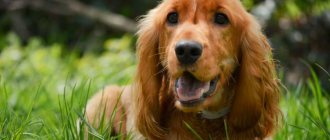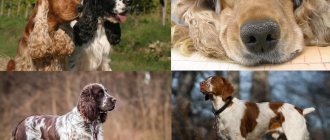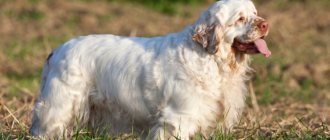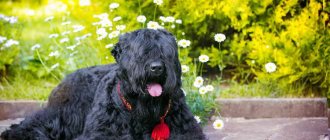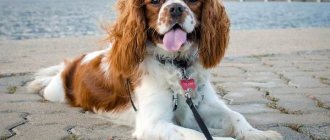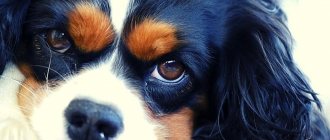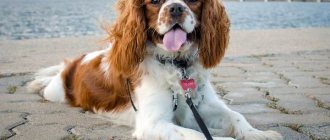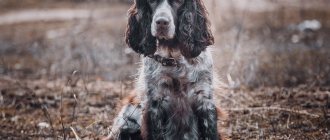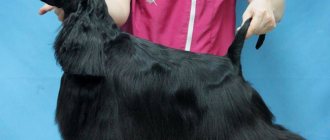Description of the Russian hunting spaniel breed
Popularity 114th place among 263 dog breeds
Lifespan:
12-14 years old
Breed group:
Hunting
Height:
males: 38-44 cm, females: 36-42 cm
Country of origin:
USSR
Average price:
from 15 thousand rubles
Weight:
13-16 kg
Latest articles Cat health
Rabies vaccination for cats: choice of vaccine, necessity, schedule 01/22/2022 15 0 0
Selection and adaptation
TOP 20 best cat breeds for families with children 01/22/2022 27 0 0
Advantages and disadvantages
- Pros:
- smart, brave, loyal, obedient;
- gets along well with children and other pets;
- not aggressive and not vindictive, rarely shows anger;
- can be kept in a house or small apartment;
- has excellent hunting abilities and a keen sense of smell.
- Minuses:
- overly energetic and active, therefore needs long and frequent walks;
- susceptible to obesity and food allergies;
- requires special care for the coat and ears, and often suffers from otitis media.
Reviews from breed owners
Reviews about the breed are mostly positive . Owners describe Spaniels as loyal and obedient hunting dogs, but believe they are not suitable for everyone.
- The first disadvantage is excessive activity and the need for frequent long walks.
- The second is a lot of wool.
- The third is diseases.
Thus, the owner of an adult Spaniel, Irina, writes: “These pets are unpretentious in their maintenance, survive frosts well, and eat everything. Very bright both in appearance and in character. They are loving, affectionate, playful, and are completely devoted to serving their owner. Indispensable during hunting. But they need careful care, especially for ears and fur. Dogs are very active and can be destructive. Without education, they become leaders in the family.”
Another owner believes that all dogs are worthy of attention and respect, but Russian spaniels are special: “You immediately fall in love with the eyes of this pet. You may not like animals, but a dog of this breed will win your heart. Our pet is loyal, playful, active. The only genetic drawback is frequent illnesses and epileptic seizures.”
Key facts
The Russian Spaniel is an energetic, lively, inquisitive, optimistic and friendly pet. Nature has endowed the dog with excellent sense of smell and amazing endurance, which allows it to quickly and easily find birds in marshy or dry areas.
The spaniel is an incredibly smart, loyal and obedient dog that is strongly attached to its owner. He gets along well with small children, cats, dogs, and other pets. Such a pet will be an ideal companion for an active family and is definitely not suitable for elderly and constantly busy people.
Description of the Russian Hunting Spaniel breed includes:
- high level of intelligence;
- friendliness, sociability;
- well developed hunting qualities;
- easy training and education;
- rapid adaptation to a new environment;
- unpretentiousness in everyday maintenance, nutrition, care.
If the spaniel is considered in the role of a hunter, it is worth noting such qualities as: perseverance, activity, endurance and complete obedience. The pet swims well in water, dives, and follows all the owner’s commands if it is raised correctly.
The characteristics of the Russian hunting spaniel breed emphasize that this hunting dog is hardy, energetic, patient, persistent and at the same time attached to the owner and his family.
With proper maintenance and proper nutrition, the life expectancy of the Russian Hunting Spaniel is 9-11 years. For a hunting dog this is a normal period. Long-livers occur, but not so often.
The spaniel tolerates cold well, which makes it possible to keep it in the enclosure of a private house. In the winter season, the owner needs to take care of insulating the booth, since without the proper conditions the dog can get sick.
Breed characteristics and character
The Russian Hunting Spaniel is widespread in Russia and is recognized by the Russian Canine Federation. But, despite this, it is not yet included in the list of the International Canine Federation.
Russian hunting spaniels on a walk in summer
However, domestic breeders do not strive for global recognition of the dog by the entire planet. Today it is enough for them that the dog is listed on the European market. In the Benelux countries there are exhibition events and endurance tests associated with this breed. In addition, dog clubs and kennels are appearing.
Despite its name, the Russian hunter is considered a descendant of dogs that represent the best English group. At the same time, there are versions about the Spanish origin of spaniels. Such varieties of spaniels as water spaniels, cockers and springers came to Russia at the end of the last century. But at that time the animal failed to win the hearts of dog handlers.
Popularity came already in the post-war years. to collect a dog of the Russian hunting spaniel breed from what was available - military actions had a negative impact on the population of many breeds, and all kinds of spaniels were no exception.
Even those four-legged animals that managed to survive could not boast of pure blood. At the same time, it was expensive to supply dogs from abroad. As a way out of the situation, the idea was presented to breed their own national breed through selection. The experiment, by the way, was carefully controlled by the highest echelons of power.
The spaniel club took the breeding work under its patronage. The common goal was pursued - to adapt dog varieties to the conditions of Russian hunting. Officially, the white light was given to the Russian hunting spaniel breed in 1951, but refinement was required in the form of “pumping up skills” in endurance, strength and increasing height.
This work took about 10 more years, and by the mid-60s the “dews” confidently began to occupy leading positions at exhibitions. It took about 30 more years for the dog to become popular.
At this time there is competition between spaniels and setters. The same period is considered the starting point for the conquest of the States. In the 2000s, the first breed club appeared here. Despite the fact that, according to official sources, playfulness and carelessness in dogs disappears by 8-10 months, in fact, reviews from owners indicate the opposite.
The hunting intuition, which is revealed by this time, does not supplant the playful puppyishness. Therefore, many individuals combine these qualities into old age, remaining active and alive.
Russian hunting spaniel age 2 years old boy
These animals love walks, preferably long ones. They love to travel with their owners, especially to go outdoors. Show enthusiasm for active games such as ball and frisbee. Thanks to its sociable and extremely friendly disposition, breeders recommend considering the breed for both retirees and families with children.
But there is a caveat for pensioners - despite their advanced years, a person must be active and love walks. Otherwise, the dog will begin to mark the territory in the house where it lives. And it will be very difficult to wean her from this. Even if the dog ends up in a large family, he will not treat everyone equally.
This does not mean that he will show aggression - the “dews” are, in principle, little capable of this. But the animal will choose only one candidate as its leader. Accordingly, it will carry out commands only if they came specifically from this person. And he can simply love all the other members, wag his tail and play with them.
In addition, the dog is very loyal to kids, who tend to pull at its long, fluffy ears. The worst case scenario is that the four-legged friend retreats, waiting out the heat of passion in a dark, inconspicuous corner.
Hunting with a Russian hunting spaniel is pure pleasure. It would be surprising if it turned out differently, but the breed speaks for itself about this skill. This is a first-class bird hunter, a real hard worker, capable of making his way through the most thorny thickets and unsteady swamps.
When walking, the dog requires exhausting exercise in order to release the energy accumulated during the time within four walls. Some breeders claim that even a beginner can raise a dog. But in reality this is not entirely true. Dogs really need tedious and lengthy training, duck training if their functionality requires it, and other things.
At the same time, it is better to teach a dog to obey from the moment it crosses the threshold of its future home as a puppy. Otherwise, disappointment cannot be avoided. The dog will not grow up too spoiled, but he will still give his owners a hard time, which will be reflected in chewed shoes and furniture.
History of the origin of the Russian hunting spaniel
The animal appeared on the territory of the Russian Federation during the reign of Nikolai Romanov. He was an avid dog breeder and brought various breeds of hunting and guard dogs from abroad. The result of crossing the Italian spinone and the long-haired pointer was the birth of the Russian spaniel, which, at the instigation of the tsar, acquired practical value among domestic dog breeders.
The animals were quickly discovered to have remarkable hunting qualities and the ability to work with game and birds on land and water. In particular, they were often used in catching pheasants, a favorite dish of the imperial family. For this reason, breeding hunting breeds has become a profitable and respected business.
English dog breeders were also involved in selection: they mixed spaniels from the royal nurseries with cocker spaniels. The result was offspring that had some external similarity with their Russian relatives and had similar working qualities.
By the middle of the 20th century, through repeated crossing, breeders developed two breeds of spaniels with significant distinctive features, which are exhibited separately at breeding shows. At the same time, the unofficial English and Russian groups split.
The four-legged representatives of the “castes” differ in appearance and principle of operation, which became the reason for the subsequent mixing of both species. Subsequently, Leningrad cynologists were engaged in breeding spaniels, who bred domestic and imported dogs from abroad, significantly improving the hunting breed.
However, all their achievements were destroyed by the blockade of Leningrad during the Second World War, which is why, after the victory over the Nazis, the number of dogs had to be restored almost from scratch.
In 1950, Soviet cynologists determined the phenotype of the hunting breed and registered the standard for the appearance of the spaniel. Since 1971, mating Russian hunting dogs with other breeds of spaniels was officially prohibited, and this made the breed independent.
In the early 60s of the last century, dogs became very popular among Soviet hunters. Smart, loyal, obedient pets were and remain easy to transport; they take root well in small apartments.
At the moment, the animal population numbers more than 60 thousand individuals; the main breeding centers of the breed remain: Moscow, St. Petersburg, Yekaterinburg, Saratov, Samara. To improve knowledge about the hunting breed in America, the Spaniel Club was opened in 2000, where spaniel owners can register their four-legged friends.
Appearance of Russian hunting spaniels
General impression
In life and in the photo, the Russian hunting spaniel is a strong, muscular dog of an elongated format. At the withers it is taller than English Cocker Spaniels, but smaller than the Springer.
Since Soviet breeders paid main attention to endurance, courage, and search characteristics, the eared animal looks a little primitive. Of course, he is far from the glamorous Americans, but he is not without restraint in grace and lightness of charm.
Head
Oval in shape, elongated, wide, with a well-defined skull, the head of the Russian Hunting Spaniel is quite large, while it tapers towards the nose. The forehead is convex, the arches above the eyebrows are well developed. The line of the muzzle is parallel to the line of the forehead. The transition between them is noticeably pronounced.
If you look at the head from the side, you can see that the upper lip is shaped like a rectangle with slightly rounded corners. The lips and nose are black or light brown.
Neck
Moderately long, well developed muscles.
Torso
Sturdy and slightly elongated. The topline is sloping, the back is wide, the loin is short, smoothly turning into a sloping croup. The chest bone is wide, the pelvis is taut.
Front and hind limbs
The front legs are straight, bony and parallel. Elbows set back. The forearms are straight, the pasterns are voluminous, slightly inclined. The length of the legs is ½ the height of the animal at the withers.
The hind limbs are straight and spaced slightly wider than the front ones. The spaniel has short shins and voluminous, straight-set metatarsals. The paws are rounded and arched, the toes are pressed tightly against one another, separated only by long hairs.
Tail
Mobile, thickened at the base. It decreases by half after birth and is located along the line of the back when walking.
Movements
Free, energetic. Animals move well both on land and in water.
Wool
The coat is elongated and noticeably wavy. The guard hair is shiny and adheres well to the animal's body. The head and all limbs are covered with a short and dense coat.
There are longer hairs on the back, croup, sides, and top of the neck. The chest, lower neck, groin and back of the paws are covered with abundant hair, forming dewlaps.
Colors of the Russian Hunting Spaniel
The breed is characterized by 3 types of colors: uniform, 2- and 3-color. Animals with solid colors are dark red, brown, black, and white markings on the throat or sternum are acceptable.
Two-tone spaniels combine similar colors, but they are broken up with distinct light spots. Tricolor - black and white, brown pets with a slight tan. The color may contain inclusions that do not match the main tone of the coat.
Russian hunting spaniel size
The height of the Russian Hunting Spaniel at the withers for males reaches 39-45 centimeters, for females – 35-40 centimeters. The weight of a Russian hunting spaniel in adulthood does not exceed 22 kilograms.
Breed standard
Russian hunting spaniel dog standard was approved in 1951, and a few decades later it began to appear with representatives of other hunting breeds. Unfortunately, this led to the birth of “hybrids” - different crosses of dogs. Few of them can be considered purebred.
A high-quality representative of the breed has a lean, muscular build. It should be slightly elongated in shape. The weight of an adult animal is from 11 to 17 kg. The height of females is up to 42 cm, and that of males is up to 45 cm. Sexual dimorphism in representatives of the breed is practically not expressed.
These animals have a wide back (bitches are slightly narrower than males). She is muscular and strong. The groin is tightened. The back is sloping, the body is in the shape of a rectangle. The skin is elastic, there are no folds.
The loin is well expressed. The paws have very strong joints. Their arrangement is straight and symmetrical. Some representatives of the breed are born with dewclaws. Experts recommend removing them at the birth of the animal. Of course, such an operation is performed under general anesthesia.
The dog's tail is long and fluffy. If the spaniel is planned to be used for hunting, then this part of the body is docked by ½ part. For indoor representatives of the breed, this procedure is not mandatory. By the way, the dog holds his tail straight at the level of his back.
His head is large and looks harmonious against the background of his body and short neck. The skin covers it tightly. There are no folds on the head. The animal has a powerful jaw with a full set of white teeth. Scissor bite. Other options according to the standard are not allowed.
The eyes are oval-shaped with dark irises. The Russian hunting spaniel in the photo is always friendly and cheerful. His look is full of kindness. The ears are long and large. They have dense cartilage.
Hanging down. The nose is wide with wide open nostrils. In most cases it is black. May also be brown. The dog's coat is medium in length and moderately smooth. It is longer on the ears and belly than on other parts of the body.
Character of the Russian hunting spaniel
The Russian spaniel is a wonderful hunter, but in the house the dog becomes a devoted, reliable friend and companion for all family members. He quickly becomes attached to a person and tries to accompany him everywhere.
The dog loves to swim, play and frolic. If the animal is kept in a country house, it must be allowed to run freely around the site or a large fenced space.
The spaniel gets along well with small children and happily gives them all his free time. He runs, jumps, plays, and carries out all the orders of his little masters. You can leave your pet unattended with your child, as the spaniel is very friendly and would never cause any harm to his young friend.
The spaniel treats other pets in the home with patience, but he certainly won’t show the same respect to other people’s cats and will definitely kick them out of the entrusted territory. The dog does not get along with guinea pigs, hamsters, birds - the hunting instinct takes over over time, and small animals die.
In general, this is an intelligent, hardy, strong, active pet with a remarkably developed instinct of a born hunter. The character of the Russian hunting spaniel is peace-loving, loyal, accommodating, he is easy to train, loves unrequitedly and completely obeys a person.
Before adopting a dog from the kennel
Any pet with character and emotions. Call a friend who already has an animal if you have not interacted with animals. Relatives may have a negative attitude towards the decision to adopt a dog - convince them and get their consent. Walk the dog yourself, or arrange with relatives. Remember, the dog is usually walked 3 times a day. If you have children, they should be able to get along with animals. Teach them not to hurt your pet. The child should not touch the pet when she is eating or sleeping. You cannot scare or shout at the animal.
Take the Attention Test! Find 10 differences! (click right here!)
Find the answer Are you bothered by some problem or question? Enter “Breed” or “Name of the problem” into the form, press Enter and you will find out everything about the issue that interests you.
Education and training
As a rule, spaniel puppies acquire their own home and owner by 3 months of age. In the first days, the owner needs to show the baby as much attention, care and patience as possible, realizing that parting with the mother was not easy.
The puppy quickly gets acquainted with the new living conditions, its inhabitants and ceases to be afraid of extraneous sounds. Already at this time, the owner needs to start disciplining the pet - without shouting or physical punishment, teach it standard commands.
It is important to realize that a hunting dog must grow up obedient, it must have one owner with unquestionable authority. For this reason, one person takes part in training a pet, and not the whole family. It is unacceptable when someone forbids something to a dog, while another, on the contrary, allows and encourages it.
From the very beginning, the dog needs to be given a place to eat and sleep. You should not allow her to sleep on her owners’ bed or eat human food from the table. It is almost impossible to re-educate a pet after bad habits have formed.
Raising and training a Russian hunting spaniel is a labor-intensive, but very interesting task. The animal grasps everything new on the fly and completely obeys its owner. When training, it is important to use several methods that force the spaniel to remember commands:
- incentive
– when the desired action is encouraged by a treat;
- mechanical
– in studies, force is used (for example, pressing on the body, but in no case a blow);
- contrasting
– the two previous methods are combined;
- imitative
– an inexperienced dog copies the actions of a trained dog.
After mastering the training course, the spaniel will follow orders without the use of force or treats. The dog must be praised for every excellent result. Excessive punishment for disobedience is unacceptable, otherwise there is a high risk of completely losing contact with the pet.
Physical punishment can be light pressure on the dog’s back, a gentle blow to the rump with a wooden rod with a dissatisfied intonation in the voice.
Commands must be pronounced in a confident tone, loud and clear. It is impossible to replace them with orders that are similar in meaning, otherwise the animal will become confused, and the learning process will become significantly more complicated and extended over time.
Looking for a Russian Hunting Spaniel? Find your pet from 2 offers As a gift
Health and diseases of the Russian hunting spaniel
The general condition of the pet is determined by living conditions, nutrition, and the efforts of the breeder. Your spaniel should be taken to the veterinarian 2-4 times a year for tests and a general examination to identify health problems at an early stage of development.
Possible diseases
The hunting breed is predisposed to the following diseases:
- Obesity
– the reasons are unbalanced nutrition, lack of exercise and violation of the regime.
- Food allergies
– new foods should be introduced into the dog’s daily diet carefully, and if an adverse reaction from the body is detected, they should be immediately excluded.
- Otitis
– inflammation of the ear from the inside or outside.
- Blockage of the paraanal glands
– if the problem becomes chronic, then they resort to surgical intervention and their removal. All early stages are treated with medication.
- Mycosis
– the disease is provoked by parasitic fungi that affect internal organs and skin.
- Leptospirosis
– a bacterial infection affects the kidneys.
To prevent most diseases, your dog needs to have all routine vaccinations on time. Regular treatment of the animal with drugs against internal and external parasites is also required.
Reproductive health
In the Russian Spaniel, sexual maturity occurs at 9 months of age, but the first mating is not recommended before 1 year. Pregnancy lasts 55-73 days, but most bitches give birth 59-60 days after mating.
If you do not plan to breed the Russian Spaniel breed, it is better to castrate or sterilize the dog. After the operation, the animals will lose the ability to reproduce and become much calmer.
Possible diseases
Obtained as a result of selection of different types of spaniels, the dog received, in addition to its excellent qualities, unsurpassed endurance and excellent immunity. And if you vaccinate your dog on time, you can forget about diseases forever. By the way, with proper care and attention, the dog can live up to 15-16 years.
And some record-breaking dogs manage to live for two decades. Breeders believe that the main scourge of the generation, which also affected this breed, is obesity and insufficient exercise. In addition, the number of dogs that suffer from various forms of allergies, including food allergies, has recently increased.
The spaniel is no exception here. Therefore, it is worth paying great attention to the composition of the food in your dog’s bowl, the means for caring for his skin, and his walking areas. The most common ear ailments include otitis media, and skin fungal diseases include dermatomycosis. After their appearance, irritation begins and pieces of the fur coat fall out.
Among the infections typical for this breed, leptospirosis is considered to be caused by parasites caught during immersion in a pond. The dog is affected by fever, muscle tremors, and nausea. It is important to take treatment measures as soon as possible, otherwise extremely sad outcomes, even death, are possible.
Features of feeding and diet
The Russian spaniel has an excellent appetite and is ready to eat food around the clock. To prevent obesity, it is important to correctly calculate the amount of food and take care of a sufficient amount of physical activity.
So, for an adult animal leading an active lifestyle, 250 grams of dry food per day is enough. If natural food is given, its quantity should not exceed 60 grams per 1 kilogram of the dog’s weight. An increase in the norm is only possible for pets recovering from illness, nursing bitches and animals that live in an enclosure.
Three times a month, the Russian Spaniel requires unloading. On such days he should receive half as much food. The dog's diet should include beef - it is given several times a week, raw or boiled. It is better to take away a bird caught during a hunt so that the spaniel does not develop the habit of dealing with birds on its own and not bringing it to the owner.
Otherwise, the animal is fed in the same way as other hunting dogs - boiled sea fish 3-4 times a month, low-fat fermented milk products 2 times a week, cereal porridge boiled in water or broth every day.
The animal should be given vegetables, fruits, greens, boiled or raw. Sometimes you can add a chicken egg to your diet in the form of an omelet or mixed with dairy products.
Spaniels also love rye crackers, which owners often use as a reward for correctly executed commands during training. Dried fruits should be given in exceptional cases: the dog must understand that this is a “delicacy” and must be earned.
Care and maintenance
A spaniel can be kept in a house or apartment, provided it is given frequent and long walks outside. The puppy needs to immediately be allocated a place in the home: it should be secluded, protected from heat and drafts. It is important to protect a hunting dog from strong foreign odors, which can negatively affect the pet’s sense of smell.
The dog's sleeping place should be clean, with a water bowl and food bowl freely available. The dog should have favorite toys, a leash, a collar, a hair brush and hygiene products. A spaniel does not require clothing: its thick coat can protect it even in severe frosts.
An active and energetic animal requires regular and frequent walks lasting at least an hour. The spaniel loves to jump, run and play; in urban areas there are special areas for this. Periodic trips to a field or forest would be appropriate, where the animal can run around without a muzzle or leash, or swim in a pond.
The difficulty in caring for and maintaining the Russian hunting spaniel is the coat, which quickly becomes dirty and forms tangles. But if you accustom the animal to the procedure of bathing, combing and cutting from an early age, then no special problems will arise.
Particular attention is paid to the ears. They need to be cleaned several times a week with damp cotton pads, and ventilated once every two weeks by waving them from side to side for several minutes.
Teeth are brushed with a brush and a special paste several times a month. To prevent the formation of tartar, the dog is given special bones, crackers, hard fruits and vegetables.
The claws are trimmed once a month with special scissors or tongs, and the dog sharpens them on the asphalt while walking. If this does not happen, you can polish them with a hard file.
Lifespan and reproduction
Russian hunting spaniels have proven themselves to be excellent bird catchers and valuable police assistants. With good care and regular exercise, they live from 14 to 16 years. A dog's lifespan is shortened if it is poorly cared for, fed with low-quality food, or not given attention.
The breeder who breeds them must correctly select the female and male for mating. The first one becomes sexually mature earlier. A female spaniel's estrus begins at the age of 8-10 months. It is recommended to breed adult dogs, each of which is over 2 years old.
Representatives of the breed are caring and responsible parents who will entrust their offspring only to the owner. After the puppies are born, you should only pick them up if absolutely necessary.
If the dog smells strongly of a stranger, the mother dog will refuse him and will not feed him. By the way, puppies should drink her milk for at least 1 month. But, as practice shows, the healthiest dogs feed on their mother’s milk for up to 2 months. This product is the basis of their future immunity.
Tips for choosing a puppy
It is better to purchase a baby Russian spaniel from official breeders. Here you can get acquainted with the pedigree of the parents, their achievements, diplomas from exhibitions and more.
Before purchasing a puppy, it is recommended to visit the nursery several times and evaluate the living conditions. Be sure to watch how your baby eats. If he has no appetite, it means he has health problems. A healthy dog's bowl always remains empty.
At 2 months of age, the spaniel stands well on its feet, runs quickly, and takes part in what is happening around it with great interest. Choose a Russian Hunting Spaniel puppy with a clearly visible hump on the nose - this is evidence that over time the muzzle will stretch to the desired size. Individuals with straight or snub noses usually grow up with a short muzzle, which is considered a defect.
Among the pack of puppies, it is easy to spot future leaders. Such dogs become excellent hunters and loyal friends. Children are tested for courage by clapping their hands strongly in silence or by turning them over on their backs and holding them in this position for several minutes. Puppies with the makings of a hunter will react calmly to noise, but will perceive physical impact with obvious anger and will try to get back on their feet.
When choosing, another “test” is also appropriate - waving a rag in front of the puppy’s nose. The potential leader will immediately sense the “prey” and will not let it pass, clinging to it with his teeth.
Possible diseases and methods of treating them
Dogs that are distinguished by endurance and mobility often have good health. But even they get sick. Unfortunately, the Russian Hunting Spaniel has several genetic pathologies (those that are passed on from generation to generation).
These are food allergies and ear inflammation. In each of these cases, treatment is prescribed by a veterinarian. Prevention of allergies and ear inflammation - timely and high-quality care.
Adviсe:
- Feed your animal correctly, do not allow it to eat sweet, smoked, fatty or peppery foods.
- Eliminate cheap food from his menu forever.
- Clean your ears every week. Sulfur should not accumulate in them.
- When bathing, be careful not to let water get into your dog's ears.
The Russian Hunting Spaniel is a wonderful, talented hunter and a loyal companion with whom it is a pleasure to spend time. But, responsibility for its health lies solely with the owner.

